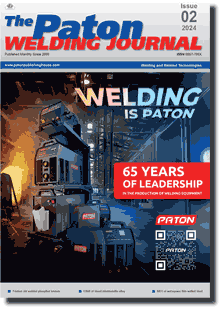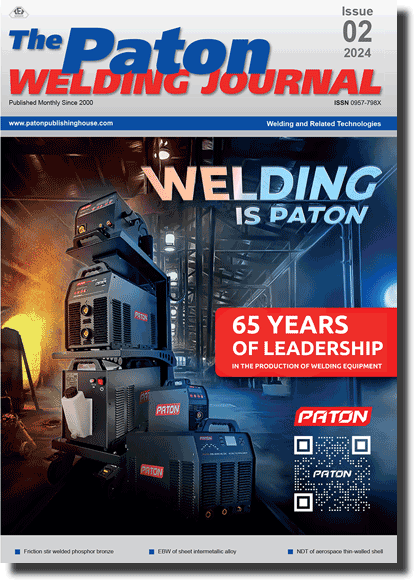| 2024 №02 (02) |
DOI of Article 10.37434/tpwj2024.02.03 |
2024 №02 (04) |

The Paton Welding Journal, 2024, #2, 14-18 pages
Strength and structure of MA2-1M magnesium alloy butt joints produced by argon arc welding with a non-consumable electrode and by friction with stirring
A.G. Poklyatskyi1, V.E. Fedorchuk1, S.I. Motrunich1, Yu.V. Falchenko1, M. Sahul2
1E.O. Paton Electric Welding Institute of the NASU.. 11 Kazymyr Malevych Str., 03150, Kyiv, Ukraine. E-mail: pag556a@gmail.com2Czech Technical University. 166 36, Prague, Czech Republic. E-mail: miroslav.sahul1@fs.cvut.cz
Abstract
The article analyzes the results of research of structural features and tensile strength of butt joints of 2 mm thick sheets of structural MA2-1M magnesium alloy produced by argon arc welding with a non-consumable electrode and by friction with stirring. It is shown that in friction stir welding as a result of intense plastic deformation of the metal, a fine crystalline structure is formed in the welds. It was determined that microhardness of the metal in such a welded joint has minimum values in the zone of thermomechanical effect on the side of the deviation near the heat-affected-zone, where the fracture of the specimens occurs during their static tension. Tensile strength of specimens of welded joints produced by friction with stirring, and specimens with penetrations removed to the level of the base material and additionally cleaned reinforcements of welds produced by melting, is at the level of 233...236 MPa, which amounts to ~84% of this index for the base material. Ref. 13, Tabl. 1, Fig. 6.
Keywords: magnesium alloy, friction stir welding, argon arc welding, structure, microhardness, strength
Received: 22.09.2023
Received in revised form: 27.11.2023
Accepted: 29.01.2024
References
1. Zuemer, N. (1998) Magnesium alloys in new aeronautic equipment. Proc. Of the Conf. on Magnesium Alloys and their Applications, Wolfsburg, Germany, 125-132.2. Luo, A.A. (2002) Magnesium: Current and potential automotive applications. JOM, February, 42-48. https://doi.org/10.1007/BF02701073
3. Shapiro, A.E. (2005) Brazing Magnesium Alloys and Magnesium Matrix Composites. Welding J., 10, 33-43.
4. Avedesian, M.M., Baker, H. (1999) Magnesium and Magnesium Alloys, Metals Handbook. Materials Park. Ohio, ASM International.
5. Sachin, K., Chuansong, W. (2017) Review: Mg and Its Alloy - Scope, Future Perspectives and Recent Advancements in Welding and Procesing. Journal of Harbin Institute of Technology (New Series), 24, 6, 1-37. Doi: 10.11916/j.issn.1005-9113.17065.
6. Hongjie, L., Jis, M., Wencai, L. et al. (2022) Influense of TIG welding process parameters on microstructure and mechanical properties of as-cast Mg-8Li-3Al-2Zn-0.5Y alloy. Journal of matecials research and technology, 20, 4114-4129. https://doi.org/10.1016/j.jmrt.2022.08.157
7. Thomas, W.M., Nicholas, E.D., Needham, J.C. et al. (1991) Friction Stir Butt Welding. Int. Patent Application № PCT/ GB 92/02203; GB Patent Applications № 9125978.8.
8. Defalco, J. (2006) Friction Stir Welding vs. Fusion Welding. Welding J., 3, 42-44.
9. Lee, W.B., Leon Y.M., Jung, S.B. (2003) Joint properties of friction stir welded AZ31B-H24 magnesium alloy. Materials Science and Technology, 6, 785-790. https://doi.org/10.1179/026708303225001867
10. Aritoshi, M. (2005) Friction Stir Welding of Magnesium alloys Sheets. Journal of the Japan Welding Society, 3, 18-23. https://doi.org/10.2207/qjjws1943.74.152
11. Poklyatsky, A.G., Grinyuk, A.A. (2001) Effect of parameters of asymmetric and modulated currents on quality of aluminium alloy welded joints. TPWJ, 7, 33-36.
12. Ishchenko, A.Ya., Poklyatskyi, A.G. (2020) Tool for friction stir welding of aluminium alloys. Pat. 54096 Ukraine, Int. Cl. В23К 20/12; PWI, No. u201005315, fill. 30.04.2010, publ. 25.10.2010 [in Ukrainian).
13. Poklyatskii, A.G. (2019) Prediction of parameters of friction stir welding of sheet aluminium alloys. TPWJ, 8, 37-42. https://doi.org/10.15407/tpwj2019.08.06
Suggested Citation
A.G. Poklyatskyi, V.E. Fedorchuk, S.I. Motrunich, Yu.V. Falchenko, M. Sahul (2024) Strength and structure of MA2-1M magnesium alloy butt joints produced by argon arc welding with a non-consumable electrode and by friction with stirring. The Paton Welding J., 02, 14-18.The cost of subscription/purchase order journals or individual articles
| Journal/Currency | Annual Set | 1 issue printed |
1 issue |
one article |
| TPWJ/USD | 384 $ | 32 $ | 26 $ | 13 $ |
| TPWJ/EUR | 348 € | 29 € | 24 € | 12 € |
| TPWJ/UAH | 7200 UAH | 600 UAH | 600 UAH | 280 UAH |
| AS/UAH | 1800 UAH | 300 UAH | 300 UAH | 150 UAH |
| AS/USD | 192 $ | 32 $ | 26 $ | 13 $ |
| AS/EUR | 180 € | 30 € | 25 € | 12 € |
| SEM/UAH | 1200 UAH | 300 UAH | 300 UAH | 150 UAH |
| SEM/USD | 128 $ | 32 $ | 26 $ | 13 $ |
| SEM/EUR | 120 € | 30 € | 25 € | 12 € |
| TDNK/UAH | 1200 UAH | 300 UAH | 300 UAH | 150 UAH |
| TDNK/USD | 128 $ | 32 $ | 26 $ | 13 $ |
| TDNK/EUR | 120 € | 30 € | 25 € | 15 € |
AS = «Automatic Welding» - 6 issues per year;
TPWJ = «PATON WELDING JOURNAL» - 12 issues per year;
SEM = «Electrometallurgy Today» - 4 issues per year;
TDNK = «Technical Diagnostics and Non-Destructive Testing» - 4 issues per year.


